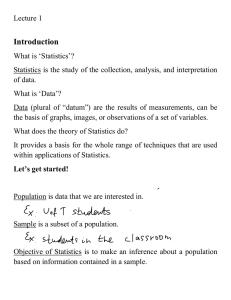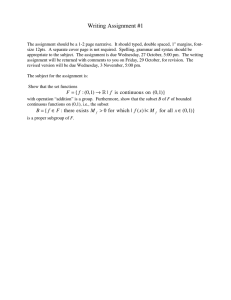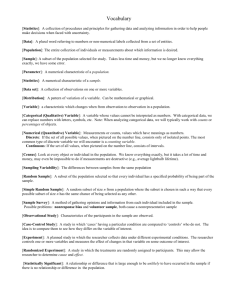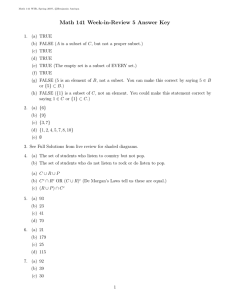8G RECURRENT AND WEAKLY RECURRENT POINTS IN
advertisement
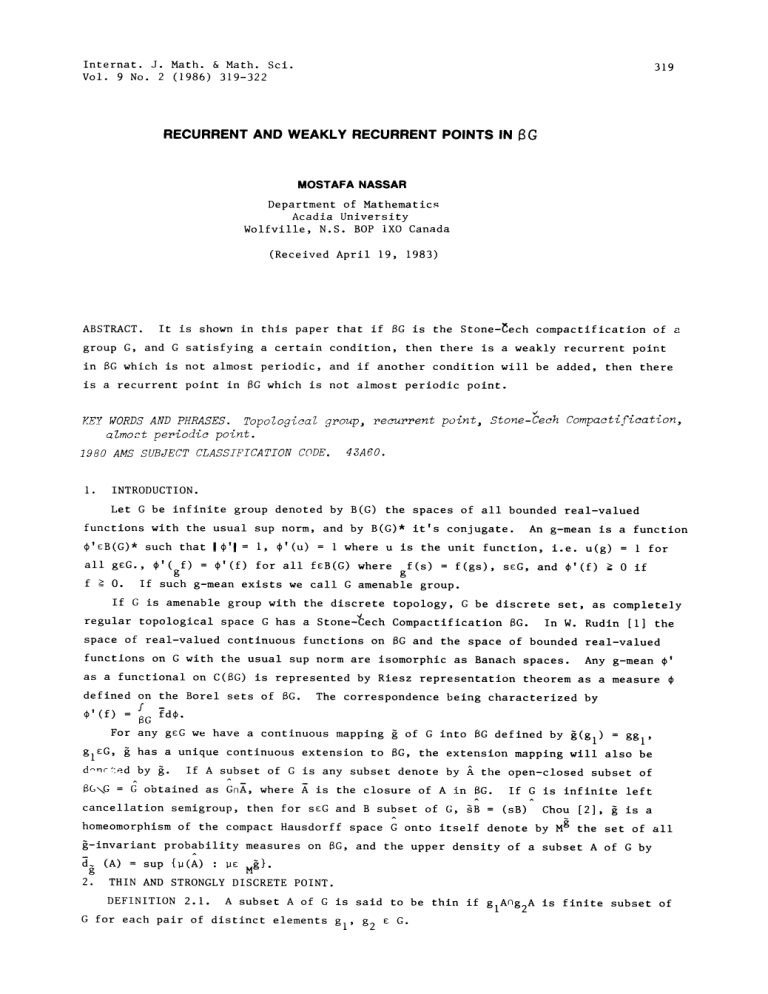
Internat. J. Math. & Math. Sci.
Vol. 9 No. 2 (1986) 319-322
319
RECURRENT AND WEAKLY RECURRENT POINTS IN 8G
MOSTAFA NASSAR
Department of Mathematic
Acadia University
Wolfville, N.S. BOP IXO Canada
(Received April 19, 1983)
Stone-ech
It is shown in this paper that if BG is the
ABSTRACT.
compactification of a
group G, and G satisfying a certain condition, then there is a weakly recurrent point
in
BG
which is not almost periodic, and if another condition will be added, then there
is a recurrent point in
8G which is not almost periodic point.
KEY WORDS AND PHRASES. Topological group, recurrent point, Stone-Cech Compactification,
almost periodic point.
1980 AMS SUBJECT CLASSIFICATION CODE. 43A60.
I.
INTRODUCTION.
Let G be infinite group denoted by B(G) the spaces of all bounded real-valued
functions with the usual sup norm, and by B(G)* it’s conjugate.
’
I, ’(u)
’eB(G)* such that
where u
all geG., ’(f)
’(f) for all feB(G) where
g
f(s)
for
f(gs), seG, and ’(f)
0 if
g
If such g-mean exists we call G amenable group.
0.
f
An g-mean is a function
is the unit function, i.e. u(g)
If G is amenable group with the discrete topology, G be discrete set, as completely
regular topological space G has a
Compactification 8G. In W. Rudin [I] the
Stone-ech
space of real-valued continuous functions on BG and the space of bounded real-valued
functions on G with the usual sup norm are isomorphic as Banach spaces. Any g-mean
as a functional on C(BG) is represented by Riesz representation theorem as a measure
defined on the Borel sets of
f
BG
’(f)
BG.
The correspondence being characterized by
d
For any geG we have a continuous mapping
gl eG,
R
dnrted by
G\G
R
of G into 8G defined by
R(gl) =ggl’
has a unique continuous extension to BG, the extension mapping will also be
R.
If A subset of G is any subset denote by
obtained as
GnU,
where
is the closure of A in
the open-closed subset of
G.
cancellation semigroup, then for seG and B subset of G, B
If G is infinite left
(sB)
Chou [2],
R
is a
homeomorphism of the compact Hausdorff space G onto itself denote by M R the set of all
R-invariant probability
d~ (A)
sup {(A)
g
2.
measures on G, and the upper density of a subset A of G by
THIN AND STRONGLY DISCRETE POINT.
DEFINITION 2.1.
A subset A of G is said to be thin if
G for each pair of distinct elements
gl’ g2
e G.
glAg2A
is finite subset of
320
MOSTAFA NASSAR
{gm
DEFINITION 2.2. meBG\G is said to be discrete if the orbit of m, 0(m)
geG}
is discrete with respect to the relative topology that is if and only if there exists a
neighborhood U of m such that
gmU
if g
#
e.
Denote by D
G
the set of all discrete
points in G.
DEFINITION 2.3.
Uof m such that
meG is said to be strongly discrete if there exists a neighborhood
G
if gl
glUg2 U
g2" Denote by SD the set of all strongly
discrete points in G.
REMARK.
so meSD
G
SD
G
is a subset of D
G.
For take gl
G, g2
e the unit element in
UngU
implies there exists a neighborhood U of m such that
G
g
e
gmU
implies
implies we D
DEFINITION 2.4.
A point meBG\G=
is said to be almost periodic if for every
neighborhood U of m there is a subset A of
which satisfy:
(ii) there exists a finite subset K of G such that G
neighborhood U of m the set A
exists
gn
gl’ g2
PROOF.
If reeD
G,
is relatively dense, in the sense there
UgnA
glAug2Au
G.
Denote by A
G
the set of all
BG.
almost periodic points in
PROPOSITION 2.5.
{geG:gmeU}
eG such that
(i) Am is a subset of U,
KA or equivalently for each
DGrAG
then there is a neighborhood V of in BG such thatVn o(m)=
hencemisnot almost periodic point, otherwise there exists a subset Aof Gsuch that Am is a
.
{m}.
subset of V which is a contradiction to the conclusion Vno(m)
G
DGnA
If A is a subset of C,
REMARK.
g
(gA)
elements
(I) If A
is empty if and only if A is finite, also
is a thin subset of the group G then
(i) Suppose that A is thin so
gl’ g2 G.
cl(glAng2A)nG
If A is thin and
()
glAog2A
But
eM
the set of all invariant probability measures on
n
(gi))
>- 0(0
i=l
G
() S !n for all
{meG:There^ exists
n -->
n
I
i=l
()
(gi )
gn pC’
n
()
(2) SD
G
neighborhood U of m,
{meG:There exists neighborhood
of m,
gl A, g2 A
.
So
gn
are
implies
0 which implies
U{clAO: glng2O 0 for all distinct
U{clAn: glAng2 A is finite}
U{:A is a thin subset of G}.
(A)
0
glUng2^
for
glUng2U
for
pair of elements
gl g2
gl g2
gl’ g2 e G}
WEAKLY RECURRENT AND RECURRENT POINTS.
DEFINITION 3.1.
meG
{ieN:meV}
is said to be
,
of m the set
is infinite.
G
G
and by R
the complement of D in
G
O.
is finite for each distinct pair of
I, hence for any distinct elements gl’ g2
$()
R
(A)
(ClglAClg2A)o (clgA0) n (clg2An)
(gl A) n (g2A)^ glng2A.
distinct and
3.
and so
is a thin subset of G}.
PROOF.
(2) SD
mAG
for geG.
THEOREM 2.6.
U{:A
Then
_m
UgeG
R
’-
-recurrent
Denote by
R
point if, for each neighborhood V
the set of all
-recurrent
to be the set of all recurrent points.
points,
So
.
RECURRENT AND WEAKLY RECURRENT POINTS IN BG
Denote by WR
DEFINITION 3.2.
the complement of SD
G
DGoA
Since
d(A)
(ii)
(K-IA)
in
the set of all weakly recurrent points in
proposition 2.5 which implies
,
it is
AGc_RGcmR
G’_
We call a subset A, a C-subset of G provided that
DEFINITION 3.3.
(i)
G
G
321
0
<
for every finite subset K of G. equivalently.
d(AUglAU...ugk_l A)
(ii)’ For every finite number k,
REMARK.
<
I.
Denote by AC the class of all amenable semigroup which
C stands for Chou.
This class contains the semigroup N of positive integers, the group Z
has a C-subset.
of integers, all countably infinite locally finite groups, all infinite abelian
cancellation semigroups, and all infinite solvable groups, with the discrete topology
for more details see Fairchild [3].
One reason for studying the C-subset is the following result
Suppose G
PROPOSITION 3.4.
contains a C-subset A then
G
A n A
PROOF.
,
Suppose An
{geG:gmeA}
Let B
subset of
AT #
say eAA
G
is open subset contains m.
since
so there exists a finite subset K of G such that G
Gc_K-I (K-IA)
{gm:geG}
hence o(m)
O(m) is closed invariant set implies there exists
(K-IA)
supp
implies
.
Then,
0AG
’(IK-I A)
IB,
Bm is a
But
a probability measure such that
which contradicts the definition of C-subset.
If A is a subset of G, I
REMARK.
K
(m) c(K-IA)
implies A
A
on A and 0 otherwise
denote the function
If GeAC then there exists a weakly recurrent point in
G
wR
almost periodic in other words
G
PROOF. Theorem 2.6 shows that SD
is a thin subset of
THEOREM 3.5.
BG which
is not
AGc
but
.AGwR
(A)
nWRG
we get
U{:A
> 0 where
Aois
G.
So there exists a weakly recurrent point
G
AGsD
#
;.
The only known method to find
a
-minimal
-recurrent
set K, then show that each meK is
in
BG
nAG
,
so
hence
which is not almost
points is to apply
-almost
0},
implies_SD G,
In Proposition 3.4 we proved that if A is a C-subset then
Moreover
periodic.
GU{:(A)
a C-subset of G, then A is not thin subset
Zorn’s
lemma to find
periodic and therefore
-recurrent.
In theorem 3.8 we are going to produce many other
-recurrent
points for a reason-
able class of semigroups.
Chou [4] has proved that
THEOREM (Chou):
Suppose that
Let
TI=T2...
be a homemorphism of a compact Hausdorff space X onto itself.
is a sequence of non-empty closed subsets of X such that a
sequence of positive integers k
Then
n=1Tn
LEMMA 3.6.
contains a
for each
2
-recurrent
<
can be found to satisfy
s>n
such that
ko
Tn+iCTn
point.
Suppose that A is a subset of G,
a subset of B of A, seN,
PROOF.
< k
(B)
0
0,
(A)
d
and SBc_A.
and neN.
Then there exists
By definition of upper -density, there exists eMg such that ( )>0.
s_->n,
(A-s)
0. Then
If
322
MOSTAFA NASSAR
. (i-in)
=I( u
i=O
i=O
This contradicts the fact that
so d ~(B)
kn(g-SA)
-in
i)
is a
Z-variant ((k)
(A -sk )> 0
s=>n
such that
(Ang-SA)
Take B
Therefore there exists
(kn-Sk)
g
A n(g
SA)
(-ink)).
But sinc.e A
(gA) so
>
then H(B)
0 and gaBs_A, but EMg
>
O.
g
DEFINITION 3.7.
The group G is said to be nontorsion group if G contains an element
of infinite order.
THEOREM 3.8.
If G is nontorsion group, GeAC, then there is a recurrent point in
which is not almost periodic.
PROOF.
Since G has a C-subset we may assume that
proposition 3.4 Ao
AT
$.
Therefore it
remains to
< s
By lemma 3.6 it is easy to construct s
such that d (A
i)
> 0 and
i-
1Ai Ai I’
i
8G
ASRG.
In other words
<
2
2,3
point by applying Chou’s theorem to the case $
A to be a C-subset hence by
produce a recurrent point in A.
A i^_ A
inductively,
2
therefore A contains a recurrent
and A
,
X
G, k
s and T
A noting
i
i
n
n
that g is an element of G of infinite order, so the function
is nonperiodic and
hence there is a recurrent point which is not almost periodic, and since
R we get
G
In fact R is much bigger than AG
G
The above theorem tells us that
# G, this answers the question raised by
Nilsen [5].
AGcG_
AGcRG.
AGuD
CONJECTURE.
If G is amenable group then there is a recurrent point in 8G which is
not almost periodic point.
In otherwords:
ASRG"
ACKNOWLEDGEMENT.
I would like to thank Professor Ching Chou at State University of
New York at Buffalo for his encouragement and advice.
REFERENCES
Cck
i.
RUDIN, W.
2.
CHOU, C. On the Size of Left Invariant Means on Semigroup, Proc. A.M.S.
(1969), 199-205.
3.
FAIRCHILD, L. Extreme invariant Means Without Minimal Support, Trans. A.M.S.
(1972), 83-93.
4.
CHOU, C. Minimal Sets, Recurrent Points and Discrete Orbits on 8N\N, lllinois,
J., of Math. 22 (1978), 54-63.
5.
NILLSEN, R.
Homogeneity Problems in the Theory of
Math., J. 23 (1956), 409-419.
Discrete Orbits in
8N\N, Coloq. Math.
Compactifications, Duke
33 (1975), 71-81.
23
172



